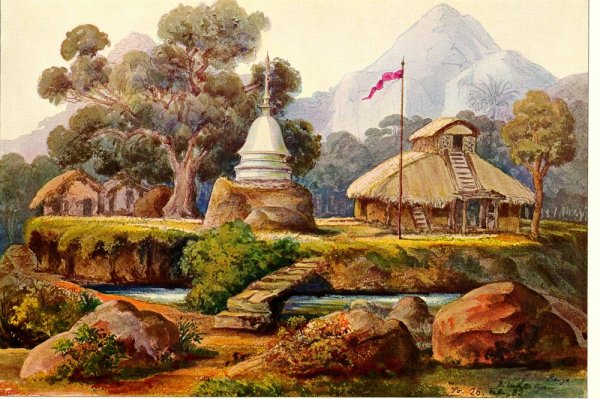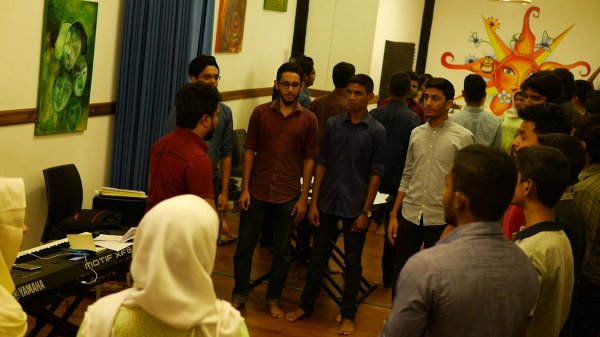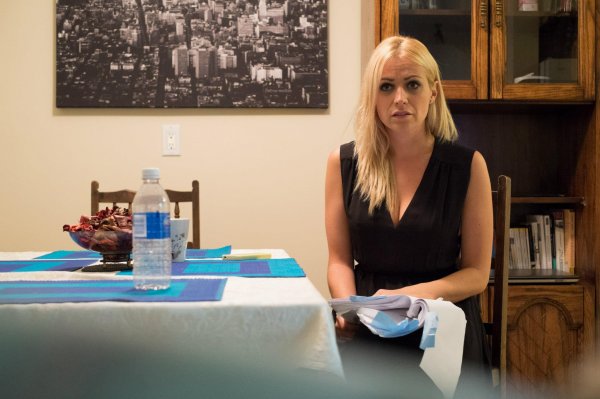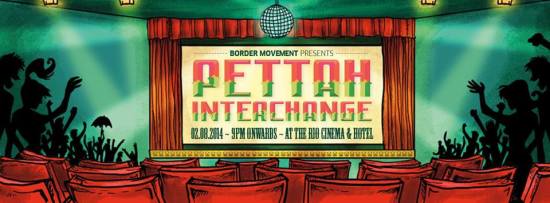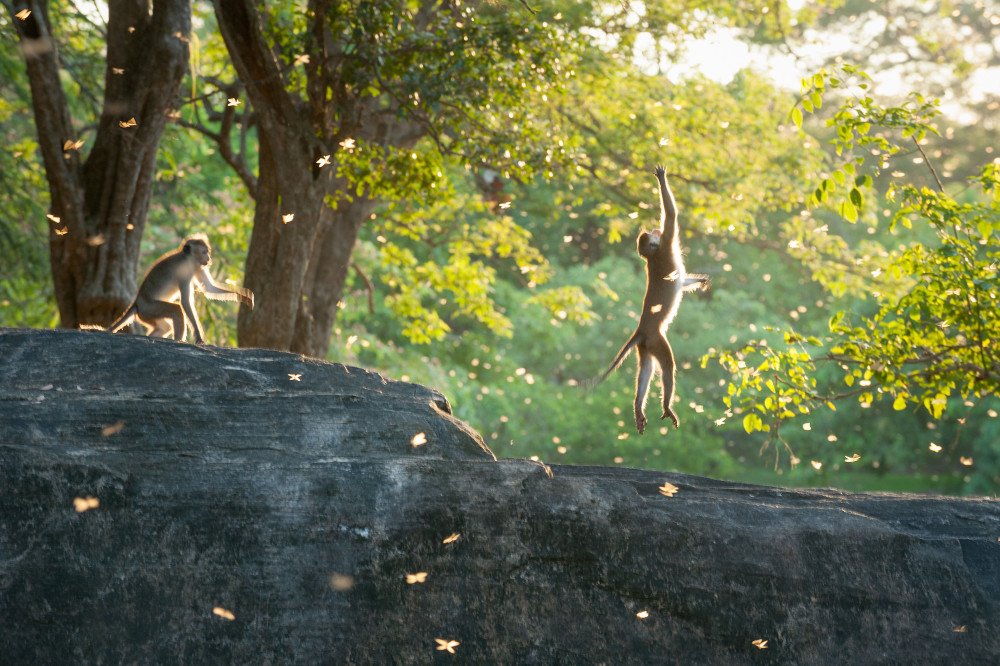
Crawling out of bed to watch Monkey Kingdom, airing at Savoy at 9am, was absolutely worth the sleep deprivation. This docu-drama was special for more than one reason: it wasn’t just the right mix between entertainment and education about the social structures and hierarchies of our fellow primates – the cherry on the cake is that it was filmed in Sri Lanka, with sweeping scenes of the landscape and ruins at Polonnaruwa.
While it brought home important lessons, we couldn’t help but wonder about a few things related to the filming and the scripting – let’s face it, how on earth did they manage to film some of those scenes? Does nature truly engineer Disney-esque happy endings? Was it all scripted or sheer luck? Because we at Roar couldn’t rest until we found out – and we’re sure everyone who watched it had similar questions – we did a bit of digging and found the man behind the monkeys. Meet Dr. Wolfgang Dittus who has been studying macaques in Sri Lanka for over four decades. Incidentally, his study is also the longest-running monkey study of all time, with the findings of his study featuring in several documentaries and now, more recently, in Monkey Kingdom.

Dr. Jane Goodall, Disney Nature Ambassador and founder, The Jane Goodall Institute with Dr. Wolfgang Dittus, Scientific Consultant, in the Monkey Kingdom – Photo courtesy: DisneyNature
Although we could endlessly wax eloquent about the movie, we’ll just stick to treating our readership with an exclusive interview with Dr. Dittus about Monkey Kingdom and his research in Sri Lanka.
Where did the idea come from? How did Disney suddenly hit upon monkeys in Sri Lanka? Did you pitch the idea to them or was it the other way around?
It was a meeting of the minds: we had the science and knew how to film monkey behavior while Disney had the resources for a major production. Over the last 35 years our studies on the primates at Polonnaruwa have been the subject of over 20 TV documentaries that had been broadcast internationally on the BBC, Discovery Channel, Animal Planet and others (including Rupahavini). But, I had always dreamed of showing our monkey studies on a big screen in a movie theater, preferably IMAX. The opportunity presented itself through Mark Linfield who, with our help, had 12 years earlier produced the award winning TV documentary “Temple Troop” at Polonnaruwa. Mark had since then directed other films for Disney Nature. We pitched the idea to Disney – and now we have our film.

Wolfgang Dittus, Scientific Consultant with Chameera Pathirathne, and Sunil Rathnayake, Scientific Assistants, observe some monkeys in the ruins – Photo courtesy: DisneyNature
The film is in keeping with our philosophy for conservation: namely, that people will only conserve what they love, will love only what they know and understand, and will understand only what we teach them. It is our duty as scientists, then, to raise peoples’ consciousness and enthusiasm for the rich tapestry of our primate heritage. TV and films offer the best medium for communication. That is what Monkey Kingdom does for us.
How long did it take to film the movie? When did the shooting start?
The actual camera shooting time lasted nearly 3 years from mid-June 2012 to mid-March 2015. It involved over 1000 cameraman-days, and about twice as many monkey-naturalist-days in support of the camera crew. The monkey naturalists team included Sunil Gunathilake, Chameera Pathiranne, Sunil Rathnayaka, Dinesh Chandrasiri and Nimal Perera.
Was there a ready script or did the story evolve based on the footage?
The overall story arc was based on tried and tested themes that had been used by us in earlier TV productions with the Polonnaruwa monkeys, such as “Temple Troop” (BBC Natural World) or “Dark Days in Monkey City” (Animal Planet), but the details of the narration were adjusted to fit the best filmed images and the evolving story. Story arcs had been developed over the years by myself in collaboration with various film producers.
What were the logistics of filming like? Any amusing stories of mishaps in the wilderness you would care to share?
The logistics of filming were a mix of daunting, frustrating and rewarding happenings. For example, the filming of the feeding bonanza on the elate termites required delicate timing to coincide with three not-easily-predicted events: the onset of the rains, the decision by the termites to actually respond to the rain and, finally, good light for filming. In 6 years of trying to capture this unique behavior on film (including for “Temple Troop”) we succeeded only once in 2014. When the rains began our primate research staff scouted the forests daily for this elusive event that last only 1-3 hours. When alerted by them that “it’s starting” you can imagine three cameramen racing in a frenzy from one location to another where termites were swarming – the equipment is heavy – it’s like weightlifters having to jog shouldering their burden with swarms or termites landing on their faces and camera lenses.
The frustration came in being stymied from filming some beautiful scenes owed to the absence of cooperation of a few local authorities. But we were compensated by the monkeys with their sometimes surprising antics – like the male macaque arrogantly striding between Maya and her grooming partner as though they did not even exist. The images that we are able share with an audience are the result of hard work, persistence, know-how and luck.
We’re curious to know – how were the shots in the town and the underwater shots taken? Was it preplanned or did the crew just follow the monkeys?
We were aware of the daily habits of the monkeys, their travel routes and preferred foraging and raiding sites. The camera crew simply followed the monkeys and recorded the images. The underwater shots required some preparation in the sense of knowing where this occurs and waterproofing the camera equipment. To our surprise the monkeys were not shy of the camera underwater. That was another unexpected reward from the monkeys.

Oliver Goetzl, Field Producer, setting a remote camera in a sloth bear cave – Photo courtesy: DisneyNature
Were there liberties taken with the narrative or did the story fall into place by pure luck?
Some poetic license must be expected, even in a nature docu-drama. The Disney brand rests on a reputation of suitability for family audiences: therefore, explicit images of too much violence, blood and of sex were reduced and communicated only subtly.
Where exactly was Monkey Kingdom shot – was it in Polonnaruwa or Sigiriya?
The spectacular landscape images of the dry zone forests and hills included areas outside of Polonnaruwa, such as Sigiriya.
What has the response been after the movie? Have you received a lot of interest in your research since the movie from the general public and tourists?
Sadly, our contribution to the film as naturalists, with close to 50 years of study of these monkeys at Polonnaruwa, was not prominent in the film credits and was downplayed in the publicity given to the film production. That is an unfair trade-off that scientists often are subject to when collaborating with film producers. The filming industry is very self-serving. Even in Sri Lanka the Tourist Board uses the film to self-promote with no mention at all of who actually was at the core, inviting and supporting the production. At our research station at Polonnaruwa we do offer tourists educational tours of primates and other wildlife as advertised on our website www.primates.lk
How are the monkeys doing now? How old would Kip be now?
Female hierarchies in macaque society tend to be stable over long periods; Maya is still there as a subordinate and the Evil Sister are in control. The males, in contrast, rise and fall in rank depending on their physical condition and ability to form alliances with other males. Kumar is no longer the alpha male and nor is Raja. A new male immigrant has taken over the male hierarchy. Kip is keeping out of trouble as he matures and grows.
Have you heard of any upcoming documentaries/films about Sri Lankan wildlife?
Yes, following our film with Disney Nature we have made another film with BBC Earth that will be shown in 2016.
Your bio says you have been researching about primates in Sri Lanka for several decades now. What made you come to Sri Lanka specifically?
I came to Sri Lanka serendipitously! As a graduate student out of McGill University in Canada I was seeking a natural location anywhere in the tropics to study primate communication. The Smithsonian Institution (USA) had a program in Sri Lanka from 1966-1970, and I was fortunate to have been invited to join to study the toque macaques. My mentor, the late Professor John Eisenberg, along the late Professor Hilary Crusz (U. Peradeniya) lead a program of study and research of Sri Lankan wildlife that launched the careers of many Sri Lankan and foreign nationals.
As amazing as Monkey Kingdom is at first glance, we do have a bone to pick with Disney, however. We thought the song What a Man was spot on but apart from that, it would seem as if Disney’s standards where music is concerned has slipped. What happened to those great tunes Disney familiarized us with while we were growing up? Disney’s 1959 Sleeping Beauty for instance featured musical scores by Tchaikovsky. That said, here are a few great links and videos you might want to check out if you want to know more about Dr. Dittus’ research. Or if you simply can’t get enough of Monkey Kingdom check this and this and this and this.


